Fungi finally found how to control human behaviour to make humans help them spread
This article didn’t go into too much detail, but there are some good fungi you already use at home.
Trichoderma is super common and you want to supplement the soil around tomatoes for better yields. It has a symbiotic relationship with tomatoes and will also choke out other fungi that may cause harm to the plants. (It’s also the bane of mushroom farmers since it will colonize a substrate super quick. I am doing a heavy pasteurization on some coco coir as I type, actually.)
Then there is this one, which is super cool, A. oligospora, which will trap and consume nematodes. Unfortunately, you may have to introduce a nitrogen deficiency to see this behavior.

Fungi has had a symbiotic relationship with plants for millions of years and this is well known. Why this paper calls this experiment out now is curious.
Fungi do what no other life forms can, from breaking down poluants in the soil, absorbing heavy metals, etc.
Advancing to this kind of understanding only shows we are in the right direction to make more with far less.
Imagine the amount of land we can free by just implement advanced farming techniques, leveraged by this type of knowledge.
careful you will end up warping your crops clear across the quandrent if you aren’t managing the mycelia right.
I think I get the reference and I’m glad it came from scrolling lemmy
Risa is the mycorrhizal fungus of Lemmy.
We nuke the soil with pesticides and then sell a solution to provide what was already in the soil to begin with…





